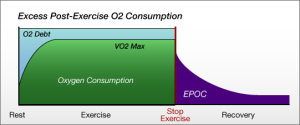Ever since the fitness industry got a hold of research showing that people burn calories after they work out while they recover from their workout, a whole new argument was born. Exercise stopped being about the exercise and became about what came after. “Do this workout,” trainers and gurus would say, “because you’ll burn four times as many calories for up to 48 hours afterward.”
Oh, if burning calories and losing weight were only that easy. After some workouts, specifically those that are intense or long, you continue to use oxygen and burn calories because you must recover from the workout and recovery is an aerobic, oxygen-using process. This increased oxygen consumption following the workout is called the EPOC (Excess Post-exercise Oxygen Consumption).

Many studies have documented the EPOC and compared it and its associated post-workout calorie burn between exercise of different intensities and durations. For example, one study had one group of individuals perform six 3-minute runs at 90 percent VO2max with 3 minutes recovery between runs, while another group ran continuously for 36 minutes at 60 percent VO2max. Another study had one group of individuals perform 20 1-minute runs at 105 percent VO2max with 2 minutes recovery between runs, while another group ran for 30 minutes at 70 percent VO2max. Both studies found that the EPOC was higher after the interval workout compared to after the continuous run. Other studies, in which subjects cycled instead of ran, still found that the interval workouts resulted in a higher EPOC than the continuous exercise.
This EPOC is transient, perhaps lasting a few hours, depending on how intense the workout was. However, the post-workout calorie burn that is caused by the EPOC is a highly over-exaggerated issue among fitness trainers. The unbridled optimism regarding an important role for the EPOC in weight loss is generally unfounded. Studies have shown that the EPOC comprises only six to 15 percent of the net total oxygen cost of the exercise, and only when the exercise is very intense. Furthermore, the type and intensity of exercise required to promote a prolonged EPOC are unlikely to be tolerated by non-athletic individuals. Since unfit individuals recover more slowly than fit individuals, the EPOC will be higher in unfit individuals, however many unfit individuals aren’t fit enough to handle the intensity of exercise that is required to induce a high EPOC.
The role of exercise in the maintenance of body weight is predominantly mediated via the cumulative effect of the caloric expenditure during the actual exercise. In other words, the calories you burn when you exercise have a greater effect on your body weight than the calories you burn afterward. It is the exercise itself that creates the demand for change.
